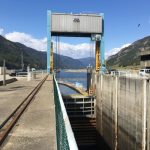Help stop this waste of valuable time and money
An open letter to the president and CEO of BC Hydro, president and CEO of FortisBC, president of Axor, chair and CEO of the BC Utilities Commission, the BC Minister of Energy, the BC Minister of Environment and Federal Minister of Environment, and all our respective MLAs and MPs in the hope that someone will step forward to make common sense prevail.
To the Editor,
In the absence of generators at the Duncan Dam in the West Kootenay, BC Hydro purchases power from FortisBC to serve its customers in the Lardeau Valley.
Meanwhile FortisBC, at their 2009 rate design hearing before the Utilities Commission, openly acknowledged that by 2020 they will virtually have to purchase power year round.
Enter Axor who propose to build hydro generators by diverting Glacier and Howser Creeks and then deliver the power to Invermere in the East Kootenay, where BC Hydro and the then BC Transmission Corporation have admitted in writing that the power is not needed.
Further, not only does the Glacier-Howser project completely fail to reinforce the power system in the Lardeau Valley area in terms of both generating capacity and upgrading of the distribution system, but even if it were connected to the local network rather than being transmitted to Invermere, generated power would only be available during spring runoff when energy and capacity would be dictated by winter snowfall magnitude.
In fact, prior to the 2009 BC Environmental Assessment Office deadline, Andy Shadrack assembled some 60 questions — including a number relating to the technical feasibility of designing — building and operating a 100 kilometres long high-voltage power transmission system over high alpine terrain.
This submission was prepared in conjunction with Brent Hancock, a retired professional consultant power system engineer who has been responsible for the design, construction and operation of high voltage transmission systems all over the world, including for such organizations as the World Bank.
In addition to our joint submission, Hancock independently submitted to the BC Environmental Assessment Office (EAO) three detailed technical evaluations of the proposed power system, questioning the fundamental aspects of the development. To date he has received no response from either AXOR or the EAO.
In fact, as far back as 2007, we have been individually and collectively questioning the financial, technical and environmental merits of delivering this power to the East Kootenay.
However, despite our best efforts, including a meeting at the 2009 Union of BC Municipalities AGM with a representative of the then Ministry of Energy, Mines and Petroleum Resources, along with MLA Michelle Mungall, we have been unable to get all the parties in the same room to have our serious technical concerns addressed.
Meanwhile, shortly after the EAO suspended the environmental assessment process, BC Hydro then informed the BC Utilities Commission that it was withdrawing its request for BCUC to issue an order amending its power purchase agreement between it and Purcell Green Power, and that the entire contract between itself and Purcell Green Power was being terminated.
At this point it became impossible to have any technical questions answered and since then BC Hydro has advised Shadrack that there are currently no intentions to issue any future power purchase calls at this time.
Shortly before Christmas, Shadrack then wrote the EAO noting that since there was no agreement to purchase power, and given the highly questionable nature of the proposed transmission line, the EAO should therefore cancel the environmental assessment process as well.
Shortly after Christmas Shadrack was advised that no provision exists in the Act and regulations to halt an environmental assessment process once started, and we have now determined that there is no mechanism for decisions of the EAO to be referenced to the BC Supreme Court as is the case for decisions made by the BC Utilities Commission.
Further, decisions of the Canadian Environmental Assessment Agency (EAA) can only be referenced to the Canadian Supreme Court after a decision has been made.
As three elected local government representatives and a citizen of BC we note that gross provincial government debt has been growing at a rate of $1 billion per year since 1990, and is now triple what it was back then.
The situation at the federal level is no better. Thus, in these days of tight fiscal circumstances, when it is still unclear whether the current recession is actually over, it makes absolutely no sense for the BC EAO or the Canadian EAA to continue an environmental assessment process on a proposed project that has no buyer and no provincial or federal government agency overseeing whether the project is even technically feasible.
We support orderly economic development that is technically feasible, socially beneficial to the local community and environmentally benign. The Glacier-Howser project, as proposed, overlooks the fact that there is already an existing hydro dam that could have generators added to it.
Further, Glacier-Howser neither supplies the local population nor delivers power closest to where it is needed.
Finally, not only is the entire project environmentally questionable, but we cannot find anyone willing to go on the record that it is technically feasible to build the proposed transmission line.
In fact in we wish you to note that in 2009 the mayors of Invermere and Radium, respectively moved the following motion, which passed, at the Regional District East Kootenay Board that a letter be sent to the Environmental Assessment Office advising that the RDEK does not support the Glacier-Howser Project for the following reasons:
• The proposed transmission line will impact high value forests;
• The environmental impacts outweigh the economic benefits; and
• The power that would be generated is not required in the Upper Columbia Valley.
We therefore collectively urge the general public, particularly local residents in the East and West Kootenays, to write and insist that this colossal waste of taxpayers’ money be halted, and that the current federal and provincial governments amend the legislation so that it is legally possible to end environmental assessment processes when they are no longer sensible to continue.
We have already seen the colossal waste of taxpayers’ and citizens’ dollars spent arguing over Jumbo Glacier Resort over nearly two decades and do not now want to see our respective governments and related agencies stack an equally large dollar amount alongside, as a result of the floored process used to evaluate Glacier-Howser.
In fact, we think that both levels of government, through their respective ministries and agencies, need to find a way to incorporate a process that tackles environmental, social and economic issues simultaneously.
Continuing the current floored environmental assessment process, before someone has reviewed the technical and engineering feasibility first, is not appropriate in the twenty-first century.
Surely, we ask, someone somewhere in senior levels of government or in a regulatory agency can help stop this waste of valuable time and money that is now unfolding. If nothing else we would at least like to see someone step forward and address the technical and engineering questions we have, before any further environmental assessment proceeds.
Andy Shadrack, director Area D, RDCK
on behalf of
Ramona Faust, director Area E, RDCK
Gerry Wilkie, director Area G , RDEK
Brent Hancock, P Eng. B.C., Alberta & Manitoba, Diploma IEE, MIEE, C. Eng U.K, (retired)



























Comments